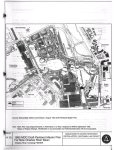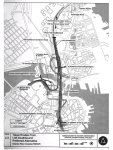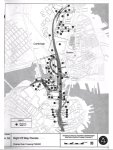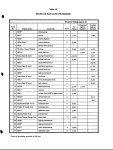I’ll be the adult here and say while I may not entirely agree with the tone, I admire each participants dogged tenacity. I welcome discussion… though not on this subject, as collars are hot for some reason.
I yield back the balance of my time.
Collars are hot because there's rather less discussion than there is lecturing without direct engagement coupled with a gigantic haze of uncertainty as to what is actually being talked about. In the interest of trying to tie up this conversation a bit, I have a few final points of thought, which I'll endeavor to deliver with a minimum of snark.
The first issue is that none of us, as far as I am aware, has read whatever agreements may exist between the state and Boston Sand & Gravel. I have tried, without success, to find such documents. We know that the Big Dig resulted in BS&G's old access road being removed and reconfigured, and it's fairly apparent that the Tobin Bridge ramps, the Leverett Connector, and probably the Zakim Bridge approaches were all built through BS&G's property. None of that was the state's simply to take by fiat. They would have had two options: fight for eminent domain (and pay whatever price the courts determined, plus the legal fees, and the delays) or induce BS&G to allow them to use their property (some of which they are still using; everywhere there's a highway support column on BS&G land is a part of their property they can no longer use). It would absolutely be perfectly reasonable for BS&G, as a private entity, to say "this is the price" for using and giving up some of their land, and for that price to include re-configured access roads, and use of the state's own access roads. (We don't know for sure that's what they did because we don't have any agreement documents, but it certainly wouldn't surprise me.) It's also not unreasonable for the state to think that such a bargain would be better than incurring the costs and delays of going the eminent domain route (especially since doing so would piss off a
concrete supplier in the middle of a massive state engineering process.)
The TL;DR version of the above is that we don't know the details, but it's objectively within the realm of reasonableness for the state to make a deal in which they essentially build a road or roads to a private facility in exchange for taking one of said facility's roads and permanently taking some of its land to build a highway through it. That's not corruption, that's a government that understands that property rights are a thing deciding that the friendly, don't get bogged down in an eminent domain case route is probably the smart move.
As to the "Entrance 1" northern access road as featured in the linked video. It objectively has uses beyond BS&G, even if they may use it more heavily than other users. It is an access point for the multi-colored state building (whatever it is, it's a state-owned parcel that appears to belong to MassDOT), and the sole meaningful access point to the stretch of Commuter Rail ROW between the Orange Line and the Lowell Line embankment separating the Eastern/Western routes from the Engine Terminal. (And I have personally seen Clear Channel and what I assume were MBTA and/or MBCR/Keolis workers on that road.) And to the extent that BS&G is the main private user of that road, it's a perfectly valid decision for the state to decide that it would rather that the cement mixers not use the back road through the BHCC campus (if that's even useable at all to get to the industrial park, so much of it is taken up by parking) or, worse, use Rutherford, to get from the BS&G plant to their satellite equipment yard. It's also entirely possible that such a road was a component of a deal between BS&G and the state, again, we don't know the details.
As to the other, hazier issue, regarding the use of the land that road is on and surrounding it, supposedly "squatted" on by BS&G (albeit in a manner that was not clearly explained), that land is effectively worthless. Between the inactive but non-abandoned Mystic Wharf Branch, the Orange Line, the Commuter Rail (including the dead storage track), and highways and their support columns, there's no meaningful room to build anything of use. It's industrial wasteland for a reason. Pick an area of industrial wasteland, any industrial wasteland, and you'll probably see vehicles and equipment strewn about without any meaningful care for where the property lines are...because it's industrial wasteland that would simply be empty otherwise. It's literally not worth caring about. If you tried to somehow tax BS&G for squatting on industrial wasteland, they'd just move any encroaching stuff onto their own property, and you the state would have wasted some of your employees' time and effort and the taxpayers' money. To the extent that they're using public land (other than roads) for their stuff, it's because it's literally not worth it to the state to care because of how little value the land has.
Again, the TL;DR version is basically this: we don't know what the terms of the agreement between BS&G and the state over the Big Dig stuff was and can't, therefore, make a final determination on its reasonableness. The rest is simply a facts-lite, foggy ideological argument, essentially over whether the state should build facilities that primarily benefit specific entities (in this case BS&G) combined with both a distaste for BS&G apparently using industrial wasteland that the state doesn't care about because it's industrial wasteland, possibly motivated by a desire to see that land be put to productive use despite the fact that its location and condition makes it, in practice, thoroughly unsuitable for development.
To the extent that the debate and discussion is over what concessions BS&G got from the state in exchange for its cooperation in the Big Dig stuff, I reserve final judgment on the terms' reasonableness until and unless someone finds the agreement documents, but I have no issue whatsoever with the state making the (frankly objectively reasonable) decision that a deal on friendly terms was better for them than going the eminent domain route. To the extent to which it's over BS&G using state land and roads not included in the deal (which may be extensive or not at all, without any deal documents, assuming that such agreement does in fact exist, we don't know) for no charge, my view is that it's simply not worth the state's effort to try and enforce such on industrial wasteland. BS&G will simply move its stuff off the state's land (and the next time there's a state construction project the price of concrete might go up a little) and the state will have wasted its energy for nothing. And to the extent that it's about the desire to develop or otherwise productively re-use that land, and BS&G being the obstacle to that (rather than it being industrial wasteland), my view is that the contention that BS&G is a fatal blocker has not been supported by evidence, and the land in question is largely valueless for any meaningful development anyway.
If you've managed to read this entire wall of text, congratulations, here's a delicious virtual cookie

for sticking with it, and without objection my participation in this particular conversation is adjourned.









